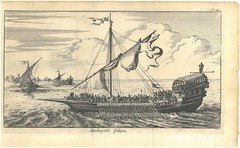SLAVES
High School Students Lead an Exhibition Preparation on European Slaves
In 2019 the University of Innsbruck presented the exhibition "Captured by Pirates: Slavery and Piracy in the Mediterranean (1500-1800)" in collaboration with the Art History Museum in Innsbruck’s Ambras Castle. This exhibition was one part of the 350th anniversary of the University of Innsbruck and was organized in cooperation with the research project ESCAPE - European Slaves: Christians in African Pirate Encounters, funded by the Austrian Science Fund. It sheded light on a significant geopolitical phenomenon of the early modern period, almost forgotten today despite its far-reaching consequences: From the 16th to the 19th centuries, Europe as well as North Africa – under the influence of the Ottoman Empire – engaged in intensive piracy and privateering.
This exhibition was the first worldwide to assemble objects in connection with Mediterranean slavery and piracy. It contained autobiographical manuscripts and early modern print editions of slave narratives, ransom lists, letters written by captives, book illustrations, and visual representations, as well as everyday objects such as clothes, weapons, and commodities. 50,000 to 60,000 visitors viewed the three-month exhibition in Ambras Castle in the course of a summer, with a large percentage of the audience consisting of families with children and young adults.
By working directly with high school students, the Sparkling Science project aimed to identify concrete approaches and areas of interest to children and young adults for the planning and realization of the exhibition and the overall project. This collaboration developed new methods of museum education for the processing of historical knowledge. Through this opportunity to co-design such a well-frequented international exhibition, students had the unique opportunity to present their own research ideas and results to a wide audience. They directly experienced dissemination processes of scientific knowledge and collaboration with scientists.
Students from two schools in Innsbruck and the University of Innsbruck’s teacher training program were integrated into the preparation of the exhibition: The schools cooperated in a multidisciplinary two-year lesson plan to develop the research themes and to implement specific approaches from the perspective of children and young adults in the preparation of the exhibition in an open-ended way. The Institute for Teacher Training and School Research (ILS) of the School of Education and the area for business education within the Institute for Management and Learning (IOL) at the University of Innsbruck offered accompanying school internships at the partner schools for student teachers over the course of four semesters. The content of these internships related directly to the lesson plan of the schools and the Sparkling Science project.
In addition, the project initiated an exchange between high school students from Innsbruck and North Africa through so-called virtual classrooms. This collaboration with North African students generated intercultural input that was leveraged to fashion the Sparkling Science project in the most diversified and inclusive way possible.
This project is already completed.
Publikation
-
In: Amerikastudien/American Studies.
-
In: KLARER, M. (Ed.): Piracy and Captivity in the Mediterranean: 1550-1810. London: Routledge, S.25-55.
-
In: Archiv für Kulturgeschichte 100.2, S.461-462
-
In: KLARER, M./SPINDLER, R. (Hrsg.): Sturmers Reise: Ein frühneuzeitlicher Reisebericht aus dem sechzehnten Jahrhunderts als Graphic Novel. By Konstantin Holzmeister, Anna Kovacs, and Franziska Ulrich. Innsbruck: Innsbruck University Press, 5-8; 46-47.
-
In: International Journal of English Studies.
-
Berkeley: University of California Press, 2021.
-
London: Routledge.
-
Wien: Böhlau.
-
Wien, Innsbruck: Haymon.
-
London: Routledge, 2019
-
In: American Studies in Scandinavia.
-
In: KLARER, M. (ed.): Mediterranean Piracy and Slavery in World Literature: Captivity Genres from Cervantes to Rousseau. London: Routledge, S.25-46
-
New York: Columbia University Press, 2019.
-
In: KLARER, M. (Ed.) (2018) Piracy and Captivity in the Mediterranean: 1550-1810. London: Routledge, S.128-143
-
In: KLARER, M. (ed.): Mediterranean Piracy and Slavery in World Literature: Captivity Genres from Cervantes to Rousseau. London: Routledge, 2019, S.175-194

